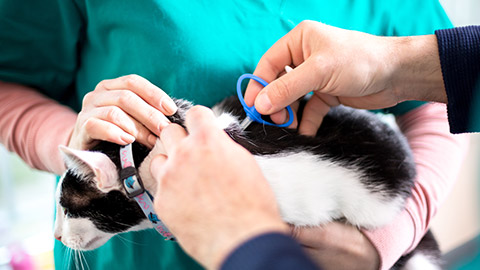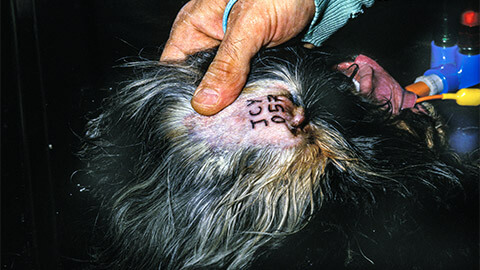Animals that enter your care facility must be able to be correctly identified to distinguish them from others within their species/breed. Some general identifiable characteristics that can be used as part of your record-keeping practices include most of the content that we have covered in this module and in other parts of this programme:
- Age, sex (gender), and size (weight, height) of the animal - You may have to provide an educated guess of the animal's age if it is a stray or wild/native.
- Coat or skin colours and texture - Certain species and breeds will have common coats and skin colourings however individual animals may have unique characteristics such as markings, patterns, and/or permanent scars.
- Eye colour - Might be breed-specific however some animals have different eye colours in the left / right eyes which are unique.
- Nail colour - For example, dogs may have dark or light colour nails (claws).
- Movement and behaviour - Physical characteristics such as chronic limping.
Animals can also be identified using permanent identification methods. These are man-made devices, objects, or markings that can be used as a way to determine who owns the animal.
Permanent identification methods used for companion animals include:
- Microchipping
- Tattoos
- Leg Bands

A microchip is a tiny device implanted under the skin, usually in the neck area where it is unlikely that the animal can bite or scratch it out. It is read by a small scanner that will show the contact details of the owner. Microchipping is mandatory for dogs in New Zealand and highly recommended for all other pets. All of the companion animals covered in this programme can be microchipped. Once your pet is microchipped it can be registered here: Animal Register
This is a great tool – if your pet goes missing or is stolen it means that ownership is very clear and increases the likelihood that you and your animal pal will be reunited.

In New Zealand this really only applies to dogs as other companion animals are really just too small or fragile to tattoo without stressing or hurting them. The most common place on the body to place the tattoo is inside the ear. Given that micro-chipping dogs has been mandatory since 2006, this method is not really necessary for identification, but some breeding organisations may still require this to have dogs registered as belonging to a breed or lineage.
Rabbits may also be tattooed, but in the past it was more likely to use a permanent marker in the rabbit’s ear rather than a permanent tattoo which could stress the rabbit.

Leg bands are most commonly used for birds and are either permanent or removeable. The picture above shows a removeable leg band, which can be used on passerine birds, but is not recommended for psittacines. This is because most parrot species are smart enough to quickly remove them, making them very ineffective as a form of permanent identification. Instead, breeders will put a permanent band on the leg of a very young psittacine when its claws are still small and flexible that cannot be pulled or chewed off once the bird is older.
Summary
Permanent identification methods support owners and animal industry workers with identifying animals. As much as we might become experts on the different breeds that we work with, sometimes animals are just too difficult to tell apart without extra help. In the final topic of learning content for this module, we will be returning to the scientific studies that we started in Topic 1 when we talked about classification. Check out Topic 8 now!
